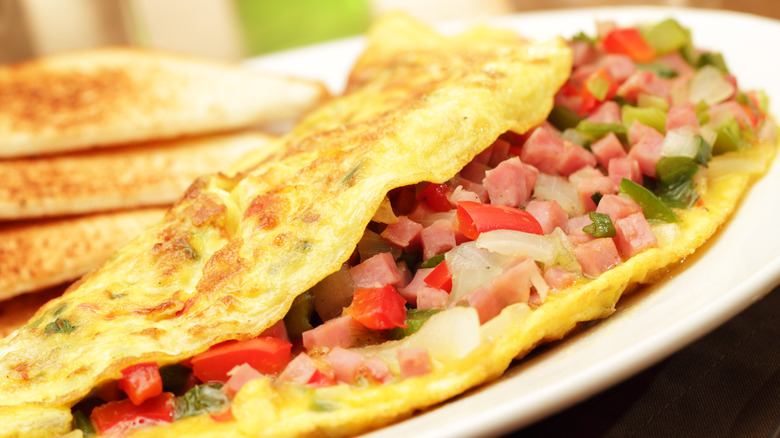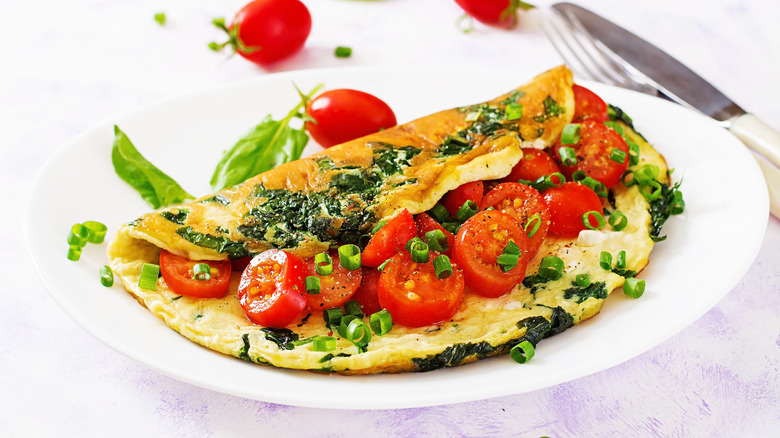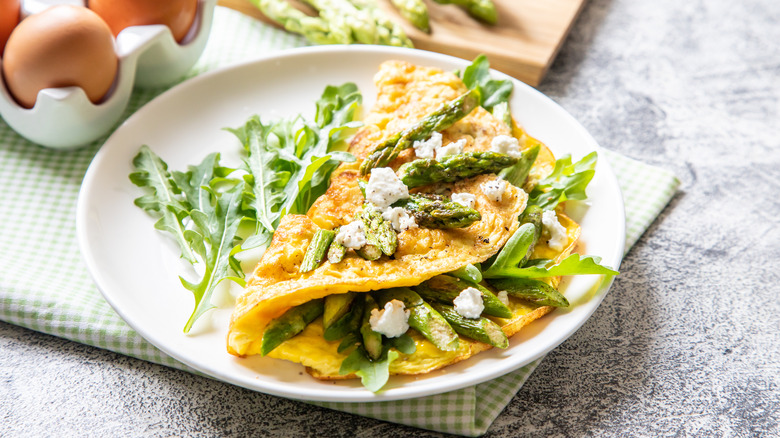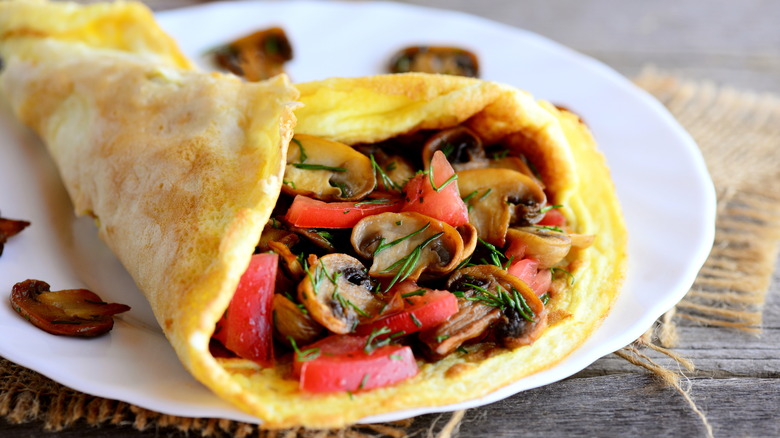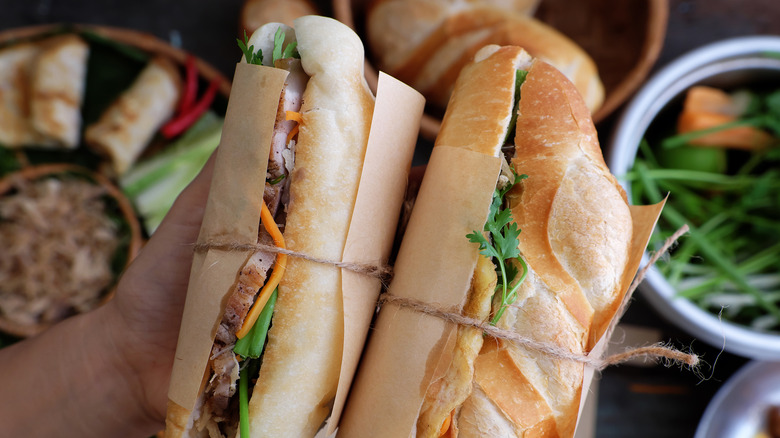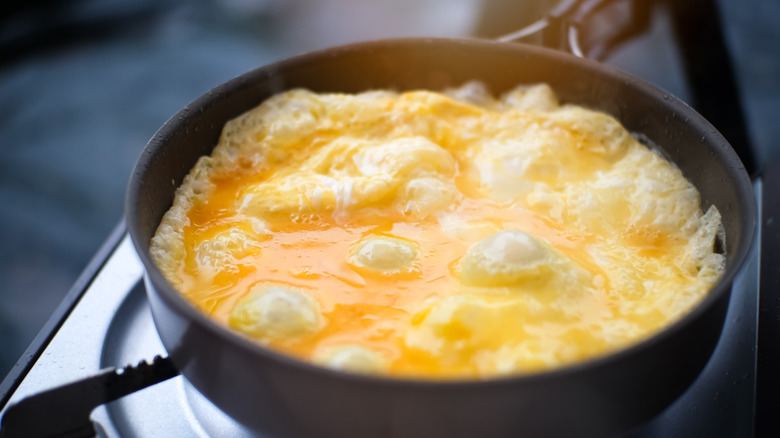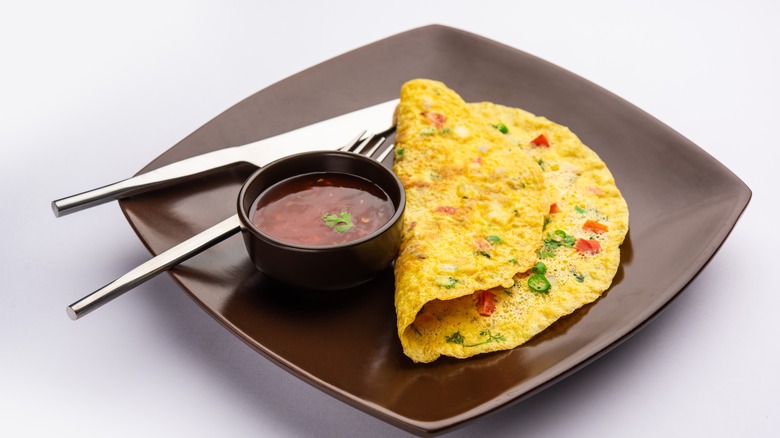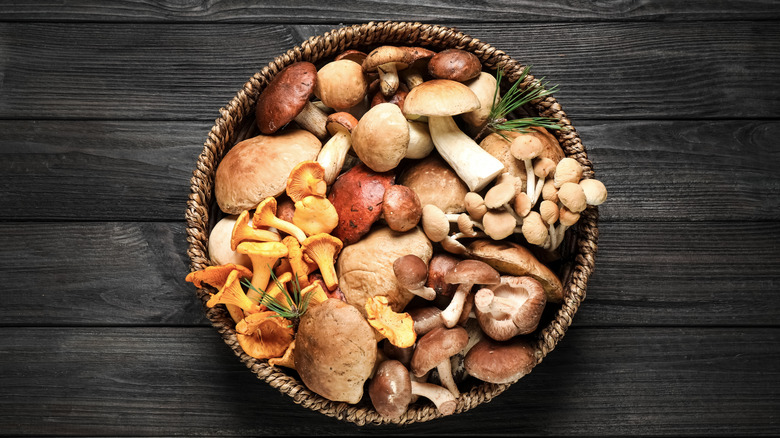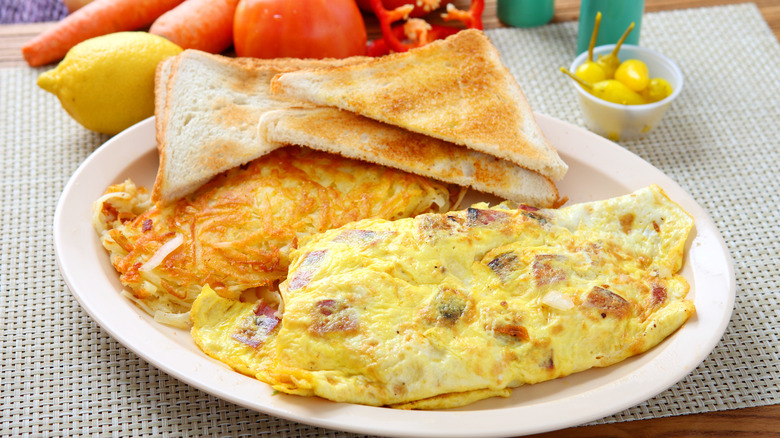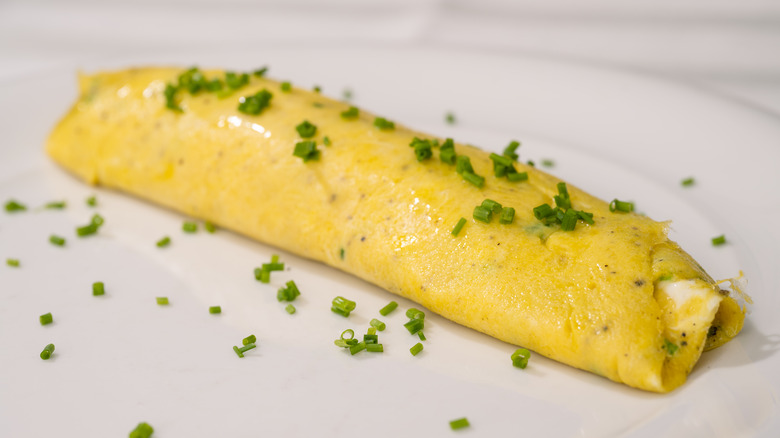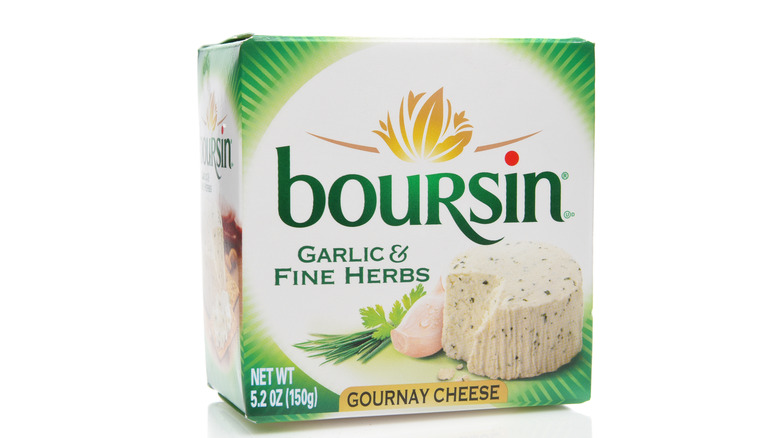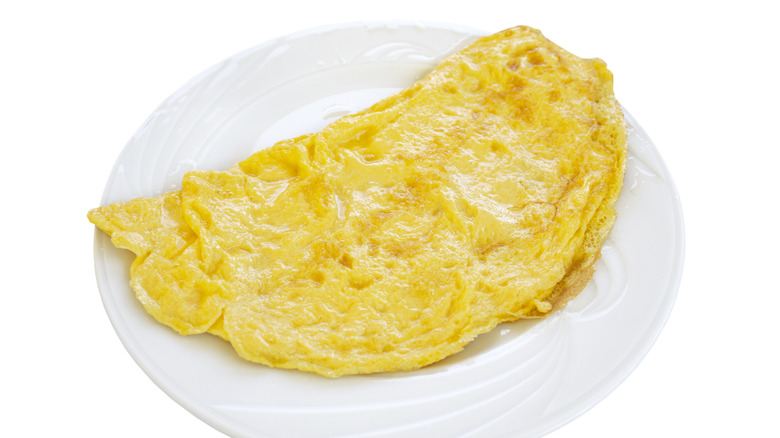16 Popular Omelet Fillings, Ranked Worst To Best
Few dishes can match the versatility and timeless appeal of a well-made omelet. One of the benefits, of course, is that almost anyone can make one, whether you're a seasoned chef or a total amateur. The other is that you can enhance them with pretty much any filling, although some are better than others due to flavor, texture, and ease of preparation.
The trick to a successful omelet, first and foremost, is to prepare a tasty, solid base. You'll only need two or three eggs for a standard-sized, individual omelet portion, but make sure you select fresh, quality specimens. Next, thoroughly whisk your eggs, adding a few dashes of water to make the consistency fluffier upon cooking. Lastly, wait until your omelet is almost cooked on the bottom before you start to flip it over. This will help keep the eggs from breaking apart.
Throughout all of this, be sure to choose the right pan. A nonstick pan is best if you're still learning, while a somewhat high edge can assist you when it comes to flipping the omelet. Meanwhile, some of the fillings may need to be pre-cooked: eggs cook extraordinarily fast, so there's no way your bacon, onions, mushrooms, or whatever you choose to put inside will cook through before the omelet burns. With that in mind, let's look at which fillings work best in an omelet, why we recommend them, and how to prepare them.
16. Spinach and oven-roasted tomato
For a healthy and nutritious morning omelet, just add vegetables. But you're not going to want to add your crunchy salad ingredients; instead, keep it soft and squishy by adding soft spinach and oven-roasted tomatoes. This filling requires a few steps and is not ideal for those who aren't big on vegetables without the benefit of meat.
Sauté the spinach in a pan before adding the tomatoes, which you will have pre-roasted in the oven. Add your eggs and make sure everything is spread out evenly across the pan. Just as the omelet is about to be ready, sprinkle some feta cheese and fold. The feta may not cook through in the remaining time it takes for the omelet to be ready, but that's no matter. Its crumbly texture won't interfere with the softness of your omelet. Rather, it will provide welcome bursts of flavor whenever you hit upon a piece.
15. Peas, asparagus, and goat cheese
Speaking of vegetable omelets, one trick for making the best is to use seasonal vegetables. When peas and asparaguses are in season, their flavor and textures are at their peak, and this inevitably comes through in the cooking process. But while few things can beat fresh, just-picked vegetables, they're not always easy to find, unless you have access to local farmer's markets. Plus, this recipe requires a fairly heavy lift when it comes to pre-cooking the filling.
For instance, you'll have to cook your scallions in olive oil to start with, set them aside for later, and then cook your mushrooms separately. Meanwhile, the recipe also calls for the asparagus and peas to be cooked separately and transferred to a bowl of ice water. All of that is before you even get to the omelet part. But if you're willing to put in the work, you'll be pleased with the result. Your last step is to add the scallions, mushrooms, peas, asparagus, and goat cheese to your almost cooked omelet, a celebration of spring in your mouth.
14. Chorizo, potatoes, and green chile
When people say omelets are versatile, it's because they can accommodate pretty much anything, including spicy ingredients. One great suggestion that puts this front and center is chorizo and green chile, along with some potatoes for balance.
Start by browning the chorizo with onions, then fry the potatoes in the rendered fat from the meat. Return the chorizo and onions to the pan with some chiles and pour your beaten eggs on top. Lastly, add goat cheese and salsa. This recipe, and many others, also calls for you to shake the pan during the cooking process. Don't skip this step. It will distribute the uncooked eggs more evenly across the pan. Another tip for even distribution is to use a heavy-bottomed pan, which will ensure even heat distribution and allow your eggs to cook equally thoroughly everywhere at once.
13. Vegetables, mushrooms, and goat cheese
This veggie and goat cheese recipe will allow you to pick your favorite vegetables and change it up as you please. For example, while this recipe uses spinach, you could add any leafy green, including kale, bok choy, or Swiss chard, depending on your preference or the season. This recipe also avoids what could be a big challenge for a new chef: the flipping of the entire omelet. To be clear, you'll have to flip the sides over towards the center, but not the entire kit and caboodle. The fact that you get to put this one in the oven at the end ensures that the omelet will be evenly cooked through, despite your fear of flipping.
Sauté the mushrooms, onions, spinach, and sun-dried tomatoes all in one, convenient pan. Set aside and cook the bottom side of your omelet. Pour in the vegetables, add the goat cheese, and bake for a few minutes at 400 degrees Fahrenheit. Fold the sides of the omelet over your filling and serve with a bit more goat cheese, for good measure.
12. Fried tofu
When omelets aren't enough, you can have an omelet sandwich, specifically this fried tofu Banh Mi. It's a little more involved than a regular omelet, and in this case, the omelet doesn't have a filling but is the filling. The result is delicious and that's all that matters.
First, pickle your carrot, cucumber, hot peppers, and radishes and set them aside. Then fry the tofu, toast your baguette, and cook the omelet. Lastly, spread some mayo in your baguette, roll your omelet on top of that, and top it with the pickled vegetables, tofu, sriracha, cilantro leaves, and more mayo. This may seem like only a few steps at first glance but don't forget to leave enough time to prepare those pickled vegetables. The carrots, cucumbers, and hot peppers will need to be julienned in order to properly absorb the vinegar, brown sugar, salt, and lemon juice pickling mixture.
11. Shrimp and yams
For a Japanese take on omelets, try this light and delicious tamago omelet. Tamago is Japanese for egg, so perhaps this is something of a redundant title, especially since tamagoyakis (the proper term for a Japanese omelet) technically qualify as omelets already. The differences are minuscule: while an American or European omelet can be made with nothing more than eggs, salt, and butter, a tamagoyaki also requires sugar, vinegar, soy sauce, and miso.
To make this one, pulverize fresh shrimp and grated yams into a paste with a food processor before whisking in the eggs, brown sugar, soy sauce, mirin, and salt. Pour your mixture into a lightly oiled pan, cover, and cook for about 15 minutes before flipping it and cooking it for about 5 more minutes. The end result will look fluffier and smoother than a regular omelet, harnessing unmistakable umami flavors from the soy sauce and shrimp.
10. Green onions, ham, and rice paper
This Asian-inspired rice paper omelet is simple, easy to make, delicious, and slightly off the beaten path, all the best figurative ingredients in an omelet. Place a whole sheet of rice paper on a lightly-oiled pan, then add sliced green onions and chopped ham. Spoon in just enough whisked eggs to cover the rice paper and cook for two minutes on each side, folding the omelet closed before flipping it. Or you can enjoy it open faced, making sure to cook the bottom side on low heat for a little longer.
If you don't see the rice paper anymore after the omelet is cooked, don't be alarmed. It's in there, but just blended with the overwhelming egg mixture. In fact, this omelet won't look any different from your run-of-the-mill breakfast food once it's cooked. The important thing is that you can taste it and feel it in the texture.
9. Spring vegetables, coconut, and shrimp
If you liked the taste of shrimp in the tamagoyaki, you'll love the coconut and dried shrimp flavor combination in this one. Toast garlic and shrimp in a pan until golden before tossing in the fish sauce, shaved coconut, lime juice, Thai palm sugar, soy sauce, coconut jam, water, and Thai bird chili and blend with an immersion blender.
Separately sauté the sprouts, or whichever light spring vegetables you prefer, and add the whisked eggs and Thai basil. Bake at 350 degrees Fahrenheit until the eggs have set and top with fried garlic chips, roasted peanuts, red finger chilis, sliced radish, cilantro leaves, and mint leaves. Yes, this recipe calls for a lot of ingredients, so you're going to have a pretty long shopping list, but if you like Thai food, you're going to love this omelet, which is great for breakfast, lunch, or dinner.
8. Good spices
Sometimes a good omelet doesn't need any fillings at all. Sometimes it just needs the right combination and balance of spices. Or at least that's what this quintessential Indian omelet has set out to prove, quite successfully. The best part? It will only take you 10 minutes to make.
Just cook your onions with fresh chiles, diced tomatoes, cumin, and cilantro along with a thin layer of whisked eggs. Then cook on both sides to the desired doneness. The key here is to use a good quality spice to ensure that the flavor will stand out. Check that your cumin is fresh before using it. If not, search your pantry for another spice that can really stand out in this dish. Luckily, this omelet can be customized in many different ways, primarily by using different spices. A homemade or a good store-bought curry powder would work wonders here, as would almost any other typically Indian spice, such as turmeric or garam masala. It's even possible to add carrot at the sautéing stage, or cheese once the omelet is on the pan.
7. Oysters
If you're a perfectionist when it comes to the shape and texture of your omelets, this recipe might not be for you. But if you constantly struggle to get your omelet to cooperate, O Ah Jan is exactly what you need. Ultimately, the appearance of this omelet is not what matters, but the flavor. This is a popular Taiwanese street-food dish, after all, so it's not going to have a fancy look.
First use ketchup, vinegar, sugar, soy sauce, cornstarch, and water to make your own sweet-and-sour sauce. Then it's time to get cooking. Start by lightly frying the shucked oysters in a pan before pouring in your whisked eggs. Add a mixture of cold water and sweet potato starch, along with some celery leaves, and continue to cook the omelet on both sides until done. It's at this stage that your typically neat omelet shape may start to fall apart. That's ok. Just sit back, relax, and let it happen, as you'll have to scrape the egg mixture toward the center. Garnish with scallions and your sweet-and-sour sauce.
6. Wild mushrooms
When you use just one, standout ingredient in a dish, you better make it good. So when you use mushrooms to fill your omelet, and only mushrooms, you better steer clear of those sad-looking pre-cut button or cremini mushrooms often found in the produce section of a supermarket. There's nothing inherently wrong with them, and you can certainly put those in your omelet; if you want to make an impressive dish, however, you must employ impressive mushrooms.
Use the best selection of wild mushrooms, such as chanterelles, porcini, and coral ramaria, all native to the Rif mountains area in Morocco. If you've picked the mushrooms yourself, even better, just make sure to thoroughly clean and prepare them before you start cooking. Begin by frying your mushrooms, separated by variety, along with some garlic. Whisk some eggs, pour in some of your mushrooms, and cool the omelet until thoroughly set. Top with the garlic and the remaining mushrooms.
5. Ham and cheese
The best things in life are simple pleasures, like those derived from eating familiar ingredients that remind us of home. So if you grew up in America, or perhaps in France, there's no way you haven't encountered the ubiquitous ham and cheese combination along the way, in various forms.
Take the ham and cheese omelet. Basically a ham and cheese sandwich, or ham and cheese wrap, with eggs instead of bread or tortillas. Actually, this recipe calls for a bit of flour to be added to the whisked eggs, so it's not that different from a wrap after all. Bake the egg mixture in the oven for 10-15 minutes at 450 degrees Fahrenheit until the egg is fully cooked, then sprinkle some diced ham and grated cheese on top. Bake for 5 more minutes to melt the cheese, then roll up the omelet into your egg-based wrap. It's the perfect sandwich trick for when you've run out of bread.
4. French herbs
Just as with spices, fresh herbs can be a quick and easy way to add a lot of flavor to an otherwise bland omelet. The best way to achieve this is with the classic French omelet, which prioritizes butter, quality herbs, and carefully whisked eggs.
Start by chopping your herbs. Our recipe recommends parsley, chives, tarragon, and chervil, but you can use whichever ones you want, which is part of the beauty of this recipe. Fresh thyme might be a good one to try, or even dill if you like its unique tang. Then whisk your eggs — not too little, or the whites won't be incorporated into the yolks, but not too much, or the eggs might fall flat — and add the chopped herbs. Use plenty of butter on your pan before pouring in your egg mixture, then fry on both sides until done. French cooking is known for often being elaborate and over-the-top. This recipe proves that it's not always necessary.
3. Boursin
With Boursin, you can get the French herb feel while also including cheese, all in one swift flick of the wrist. In fact, the first flavor made by the French cheesemaker Boursin, back in 1957, was garlic and fine herbs, particularly parsley and chives.
But if that doesn't get your mouth watering, know that Boursin now comes in many different flavors, such as the limited edition black truffle and sea salt version, which contains real pieces of black truffle, and packs a legitimate truffle flavor punch. Other flavors include shallot and chive, basil and chive, cracked black pepper, fig and balsamic, and caramelized onion and herbs. They're all equally tasty, easy to use, and will melt in your omelet, practically upon impact. All you have to do is cook a simple omelet recipe with no filling, add the Boursin to half the omelet once the bottom has set, fold over the top, and cook it on both sides until finished.
2. Ham, green peppers, and onion
Ham, green peppers, and onion are the main stars in the Western omelet, sometimes called a Denver omelet or Southwestern. You may be wondering where the cheese is at. The answer is that the pure, original Denver omelet does not include cheese, but you can certainly add some grated cheese if you like. It definitely won't hurt.
But to be a stickler about it, all you have to do here is sauté onions, diced green peppers, and diced ham in some butter before adding your egg and milk mixture. Cook through on both sides, and because this is the wild west, be sure to serve with something hot and spicy, like Tabasco or Sriracha. Alternatively, you can cook your omelet first, and add your onions, peppers, and ham raw, without pre-cooking the filling. Just know that this will lead to a slightly crunchier texture, and be sure to chop everything up into very tiny pieces, so the ingredients have time to at least warm up a bit before your eggs cook fully.
1. Cheese
If you've had too many Denver omelets and you're missing the cheese, this recipe is the cure. A simple cheese omelet is also ideal if you're looking for something soft, tasty, and comforting to fill your belly. Because all you're dealing with is cheese, pure and simple. It can even be eaten on the run, allowing you to have a quick, nutritious breakfast when you're late for work.
Just whisk together eggs, salt, and pepper and cook in melted butter on a nonstick skillet. Sprinkle your cheese of choice over half the omelet, then fold it over and cook on both sides. Once it has cooled and set, it should be soft enough to give you a warm and fuzzy feeling, and sturdy enough for you to pick up and eat with your hands. Because this recipe is so simple, there is really no margin of error. Make sure you don't get distracted while you're cooking this, remaining alert to any possible burning action. This is the recipe where you'll want to pay extra close attention to the even heat distribution of the pan and the fluffiness of the eggs.
